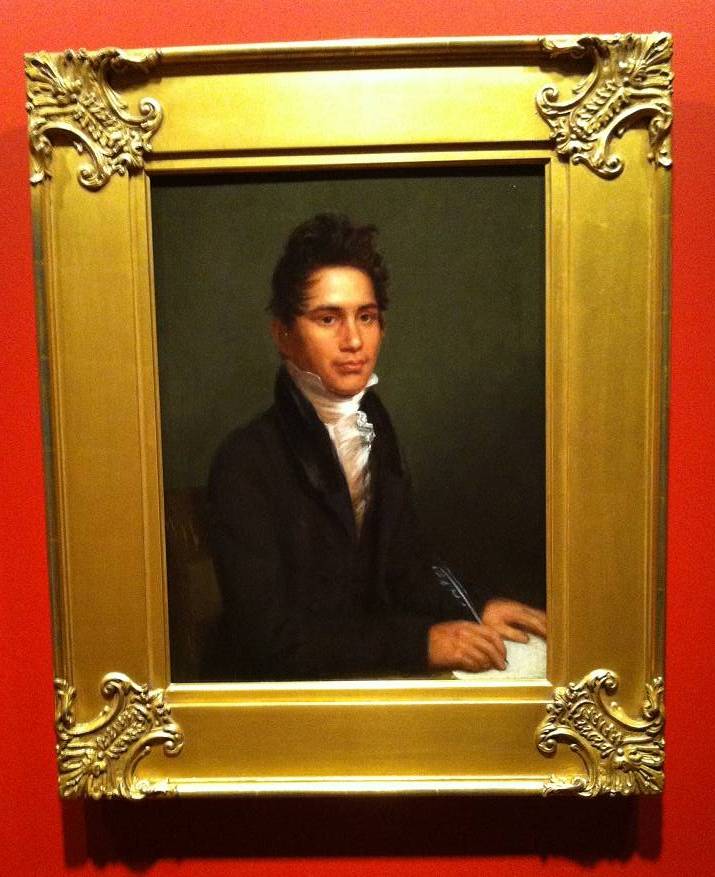Visitors who have been in our Colonial and Early Nineteenth-Century Art Gallery recently have probably noticed several changes: the Museum is currently installing a new exhibition in the small gallery space on the left: it is the third part of the American Encounters exhibition series, titled Anglo-American Portraiture during an Era of Revolution (May 17-September 15, 2014). Since the beginning of this year we also have a new small focus show in the small niche gallery where we previously exhibited James Wooldrige’s Indians of Virginia (ca. 1675). Faces of History: Charles Bird King’s Portrait of John Ridge features an exciting new art loan: a portrait of prominent Cherokee leader John Ridge painted by Charles Bird King in 1825 (courtesy of William S. Reese.) This art loan enhances Crystal Bridges’ early nineteenth-century art collection and creates a new context for the museum’s two paintings by Charles Bird King: Shaumonekusse, Otoe Half Chief (Husband of Eagle of Delight) (ca. 1822), and Wakechai (Crouching Eagle), Saukie Chief(ca. 1824). The portrait of John Ridge is also significant because it relates to local, regional, and US history.
King was one of the first American artists who chose portraits of Native Americans as his main subject. Other early nineteenth century artists from the Crystal Bridges collection who shared his interest were Peter Rindisbacher (1806 – 1834), George Catlin (1796 – 1872), Karl Bodmer (1809 – 1893), and George Winter (1810 – 1876).
King was commissioned by Superintendent of Indian Affairs Thomas McKenney (1785-1859) to paint portraits of tribal delegation members who came to Washington DC to negotiate treaties and trade agreements with the US government. McKenney believed Native American culture and tradition would be lost forever due to US westward expansion and the government’s assimilation policy: the goal of which was to assimilate American Indians into white society. In order to preserve Indian culture, McKenney established the Archives of the American Indian, the first national collection in Washington. The paintings were later transferred to the Smithsonian Institution. Unfortunately, most of them were destroyed in a fire at the Institution in 1865. The paintings in the museum’s collection and the John Ridge portrait are copies the artist created. In fact, the Reese art loan is a copy King painted for John Ridge himself, and it was in the Ridge family until the 1950s.
Compared to the two King portraits from Crystal Bridges’ permanent collection, his rendering of John Ridge appears to be different. While Shaumonekusse and Wakechai are depicted in traditional tribal regalia, usually worn on special occasions, King portrayed John Ridge in Anglo-American clothing, sitting at a desk with a document and pen in hand—hinting at Ridge’s education and career as tribal leader and politician. King was known for his realistic and sensitive renderings of his sitters, and his ability to capture their physical features and attire with dignity and attention to detail.
Ridge received his education at Foreign Mission School in Cornwall, Connecticut and served as clerk of the Cherokee National Council. When King painted his portrait in Washington, Ridge was an advisor to a Creek delegation who hoped to nullify an unlawful removal treaty signed by a few tribal members. Ironically, he would find himself in a position similar to that of these Creek treaty signers only a few years later. Originally opposed to the relocation of his own tribe, Ridge revised his opinion when he concluded that resettlement was unavoidable due to the discovery of gold in Georgia in 1829 and President Jackson’s Indian removal policy. He convinced a few other Cherokee members to sign the Treaty of New Echota in 1835 because he believed this was the only way to preserve and protect the rights of the Cherokee Nation. However, they signed the document without the knowledge and endorsement of Principal Chief John Ross and the National Party, who represented the majority of the tribe and opposed the removal. Although Ross petitioned Congress to void the treaty as invalid, it was ratified in 1836.
John Ridge and other Treaty Party members moved west in 1837—before the majority of Cherokee were displaced. He very likely took King’s portrait with him, whereas most of the Cherokee families who migrated to Indian Territory (today’s Oklahoma) in 1838 lost most of their possessions.
On June 22, 1839, after removal to Indian Territory, a group of National Party affiliates assassinated John Ridge—along with his father Major Ridge, his cousin Elias Boudinot, and other members of the Treaty Party—for selling off tribal lands (a capital crime according to Cherokee law) and the resulting forced removal of approximately 15,000 Cherokee. An estimated 4,000 Cherokee died on the Trail of Tears.
The forced Indian removal is also the subject of a contemporary outdoor installation titled A Place Where They Cried by Pat Musick and Jerry Carr (2010). The artwork is located about two miles south of one of the routes of the Trail of Tears that came through the Bentonville area.
William S. Reese, from whom King’s portrait of John Ridge is on loan, will give an Art Talk about collecting historic prints and paintings of Native Americans this Saturday, May 17, at 1 p.m. The talk is free, no registration is required.







